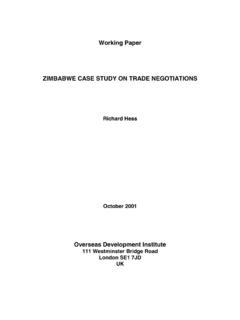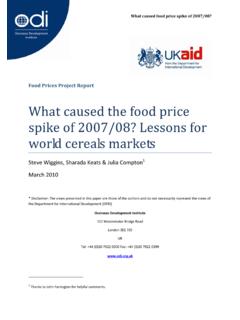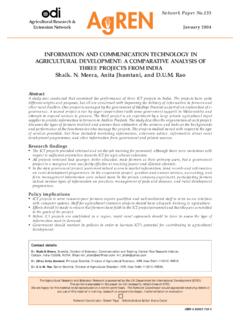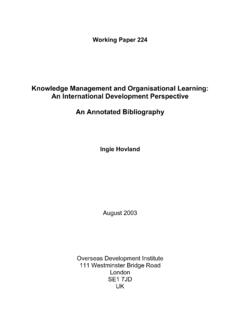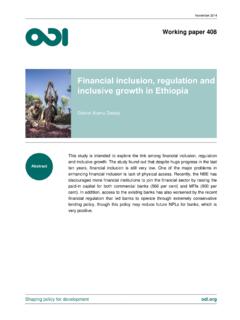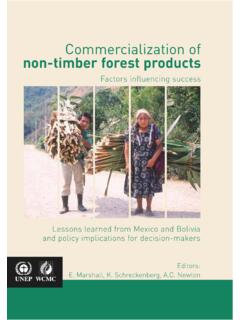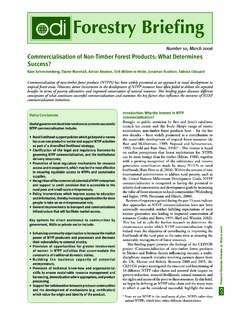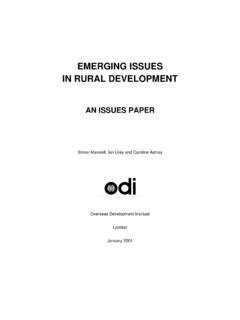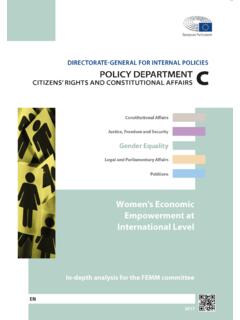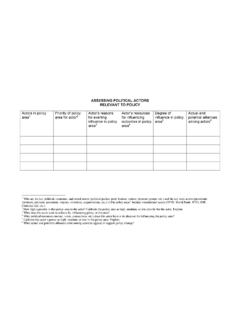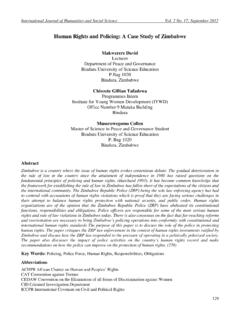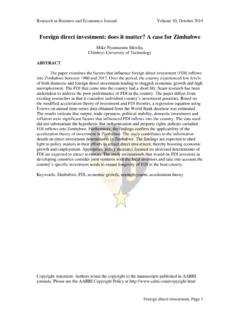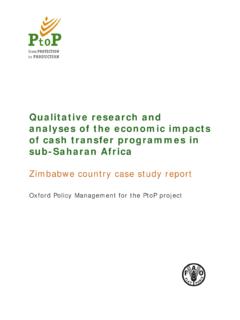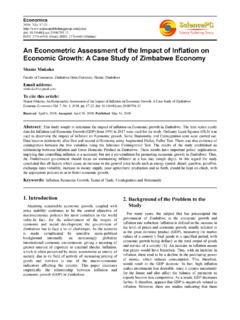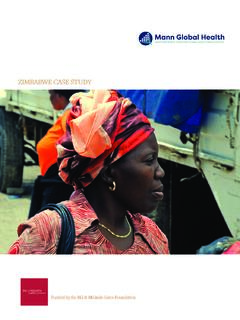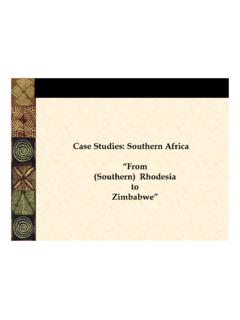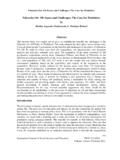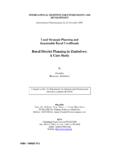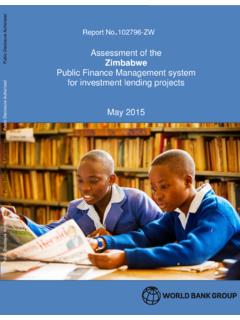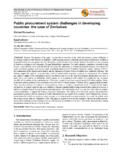Transcription of INDUSTRIALISATION IN SUB-SAHARAN AFRICA COUNTRY …
1 WORKING PAPER 25 INDUSTRIALISATION IN SUB-SAHARAN AFRICA COUNTRY case study - zimbabwe by ROGER RIDDELL ISBN 0 85003 113 3 OVERSEAS DEVELOPMENT INSTITUTE Regent's College Inner Circle, Regent's Park LONDON, NWl 4NS Preface Since early 1987, the Overseas Development Institute has been engaged on a major piece of research under the general title: ' INDUSTRIALISATION m SUB-SAHARAN AFRICA ', involving in-depth case studies of seven African countries: Botswana, Cameroon, Cote d'lvoire, Kenya, Nigeria, Zambia and zimbabwe . The case study work falls into two distinct parts. First an analysis of the INDUSTRIALISATION process from the early 1960s to the mid-1990s, followed by discussion of the options for and possibilities of accelerated INDUSTRIALISATION in the late 1980s and 1990s.
2 This Working Paper presents the first phase of the research for zimbabwe . Working Papers 24 and 26 present the first phase of the research for Cameroon and Zambia. It is also anticipated that the research work on Nigeria will be produced as an ODI Working Paper. The first phase analysis for Kenya and Botswana are being reproduced as Discussion Papers of the Institute of Development Studies at the University of Sussex from, where they can be obtained. It is anticipated that the completed COUNTRY studies incorpora-ting both phases of the research work will be published together as a book towards the end of 1989. Any further information on these Working Papers or the overall research project should be addressed to Mr Roger Riddell at the ODI.
3 ENCLOSE WITH ITEM Return Date See User's Handbook DN04002 Y LOAN (DVEF^SEAB-rn to- The Bntish Library Document Supply Centre, Boston Spa, lerby, West Yorkshire LS23 7BQ if no other library indicated. TABLE OF CONTENTS Page I. INTRODUCTION 1 II. OVERVIEW OF THE MANUFACTURING SECTOR 2 Current Status 2 Structural Change and Long-Term Expansion 4 Sources of Industrial Growth 8 Trends in Imports and Exports 14 International Comparisons of Competitiveness 23 Trends in Value Added 28 Seeking Preliminary Explanations)
4 30 III. SUCCESSES AND FAILURES AT THE MICRO-LEVEL 35 Manufacturers of Agricultural Implements 35 Inadequacies of Prices As a Basis for Policy Implementation 39 Some Concluding Observations 42 IV. THE FOODSTUFFS SUB-SECTOR 4 5 General Overview: Sources of Growth, Trade and 45 Output Trends Some Firm-Level Evidence 52 V. AGRO-INDUSTRIAL LINKAGES 58 Macro-Trends 58 Agricultural Inputs into Manufacturing 61 Manufacturing Inputs into Agriculture 63 VI.
5 CONCLUSIONS 70 Some Missing Elements 70 Towards INDUSTRIALISATION into The 1990s 72 NOTES 7 5 REFERENCES 112 LIST OF TABLES AMD DIAGRAMS Page TABLES 1. Characteristics of Manufacturing by Sub-Sector, 1982/83. 3 2. Origin of Growth in Gross Output by Sub-sector: 1952/53- 9 82/83; 1952/53-54/65; 1964/65-78/79; 1978/78-82/83.
6 3. "Sources" of Growth in Manufacturing Output by Sub-Sector, 13 1952/53 to 1982/83 and 1952/53 to 1964/65. 4. "Sources" of Growth m Manufacturing Output by Sub-Sector, 14 1964/65 to 1978/79 and 1978/79 to 1982/83. 5. Ratio of Manufactured Exports to Gross Output by Sub- 17 Sector,1952/53 to 1982/83. 6. Sub-sectoral Change in Manufactured Exports, 1980/81 to 19 1986/87, $ mn. 7. Purchases by The Manufacturing Sector by Imported and 21 Domestic Origin. 8. Self-Sufficiency Index of Exports over by 23 Industrial Sub-Sector, 1952/53 to 1982/83. 9. International Competitiveness of Manufacturing Industry, 25 DRC Calculations, 1982 and 1986. 10. Manufactured Exports By Area of Destination, 1980, 1984 and 1986, $ mn.
7 26 11. Manufactured Exports By Industrial Sub-Sector and Destination, 1980, 1984 and 1986, $mn. 27 12. Factors Constraining Industrial Expansion in zimbabwe , 33 1981-87. 13. Comparative Advantage Indicators for Foodstuffs 50 Sub-Sector 1982 data. 14. Agricultural Output and Manufacturing Inputs, 1965, 1975 63 and 1981/82. 15. The Supply of Material Inputs To The Agricultural Sector. 64 16. Purchase of Material Inputs By The Agricultural Sector, 65 1984. 17. Competitive Measures For zimbabwe 's Fertilizer Industry. 67 18.
8 Inputs into Manufacturing Obtained From Within The Manuf- 71 acturing Sector, 1975 and 1981/82. FIGURES 1. Ratio of Manufacturing Value Added to Gross Domestic 5 Product 1955 to 1983. 2. Manufactured Value Added at Fixed (1980) Prices, 1948 5 to 1983. 3. Manufacturing Volume Index, 1964-87. 6 4. Sources of Growth of the Gross Output of the Manufacturing Sector by Industrial Sub-sector, 1952/53 to 1982/83. 11 5. Sources of Growth, 1952/53 to 1982/83, All Manufacturing. 12 6. Manufacturing To Total Commodity Exports, 1939 to 1983. 15 7. Ratio of Exports To Gross Output, Total Manufacturing, 16 1952/53 to 1982/83.
9 8. Sub-Sectoral Contribution To Total Manufacturing Exports, 16 1952/53 to 1982/83. 9. Manufactured Exports, 1980 to 1986, $ mn. 18 10. Self-sufficiency Index, Manufacturing Industry, 1952/53 22 to 1982/83. 11. Manufacturing Value Added Per Employee at Fixed (Gross 28 National Income) Prices, All Sub-Sectors. 12. Ratio of Manufactured Valued Added To Gross Output, All 29 Sub-Sectors. 13. Index of Industrial Production, Foodstuffs Sub-Sector, 46 1964 to 1986. 14. Sources of Growth, Foodstuffs Sub-Sector, 1952/53 to 1982/83. 46 15.
10 Ratio of Manufactured Value Added For The Foodstuffs Sub-Sector To Manufactured Value Added For The Manufacturing Sector as A Whole, 1938 to 1982. 47 16. Food Exports as A Proportion of Total Manufacturing 48 Exports. 17. External Manufactured Trade in Foodstuffs in Relation to Gross Output of The Foodstuffs Sub-Sector, 1938/39 to 1982/83. 49 18. Index of Food Production, 1967 to 1982 at Fixed (1980 and GNI) Prices: Meat Products, Fruit and Vegetable Processing and Grain and Animal Feeds. 51 19.
